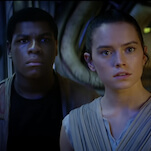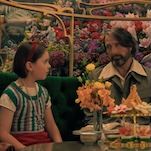Though not crucial, it helps to have a working knowledge of 1952’s Macao to decode The Last Time I Saw Macao, an oblique drama steeped in allusions to Josef Von Sternberg’s Jane Russell and Robert Mitchum-headlined noir. Together with art director/co-director João Rui Guerra Da Mata, Portuguese filmmaker João Pedro Rodrigues opens with an older blonde drag queen in a sultry Chinese dress lip-syncing to Russell’s “You Kill Me” from the aforementioned film. From there, the directors segue into a dreamy faux-genre exercise about a narrator who returns to Macao for the first time in 30 years in order to come to the aid of his friend Candy, a mysterious woman in some sort of ill-defined criminal trouble. Both these figures, as well as ominous dragon lady Madame Lobo and her assassin, are either never seen or spied only in half-glimpses (of hands, or feet). That indirectness is representative of the entire endeavor, which despite its noir pretenses, plays out not like a thriller, but like a meditative cine-essay about memory, the past, and the evolutionary changes both people and places experience over time.
While The Last Time I Saw Macao somewhat resembles a Chris Marker non-fiction effort, it nonetheless boasts its own distinctive mood, aided by cinematography that—in innumerable snapshots scored only to diegetic sounds of blaring horns, blowing wind, and running water—captures an entrancing sense of its titular city. In views of soiled stairwells and back alleys, as well as neon casino marquees and empty cabaret stages, Macao comes across as a place of simultaneous grime and glitter. And as evidenced by the narrator’s frequent musings on the modifications undergone over the past few decades—many courtesy of the Portuguese handing it over to the Chinese—the city comes to represent a place of both death and renewal, themes also echoed in the nominal narrative involving secret sects whose members can apparently transform into animals.
With its characters and action proper (gunshots, phone conversations) occurring just offscreen, The Last Time I Saw Macao boasts a style that, even at a brief 85 minutes, can be more than a tad tiresome. Moreover, its raft of references to Macao—most notable for having been a project in which producer Howard Hughes eventually replaced Von Sternberg with Nicholas Ray—do little to energize the proceedings, regardless of their relationship to the protagonist’s trip down memory lane. Still, as a ruminative travelogue-cum-dissertation, Rodrigues and Guerra Da Mata’s film is often haunting, and its portentous and mournful atmospherics ultimately help compensate for the nagging impression that it’s a work almost too personal for an outside viewer to fully penetrate.









































